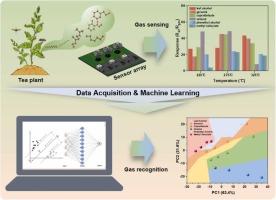Machine learning-assisted ZnO-based sensor for multi-species recognition of volatile aroma components in tea plant
IF 8
1区 化学
Q1 CHEMISTRY, ANALYTICAL
引用次数: 0
Abstract
The aroma profile of plant (e.g. tea plant) is mainly influenced by various aromatic substances such as leaf alcohol and geraniol, which play a crucial role in determining the quality of growth and can be also served as biomarker to evaluate the infestation of pests and diseases. Therefore, the detection of volatile aroma components is of great significance to assess the quality and monitor the pests and diseases in plant. In this work, ZnO-based sensor is fabricated to investigate its gas-sensing performance towards six types of representative tea aromas (leaf alcohol, geraniol, capraldehyde, octanol, phenethyl alcohol, methyl salicylate). As a result, the ZnO-based sensor shows the highest gas-sensing response (∼110) with a fast response/recovery time of 29 s / 7 s for 10 ppm leaf alcohol at 325 ℃, and exhibits an impressive limit of detection for leaf alcohol as low as 0.5 ppm with a gas-sensing response value of 6. Meanwhile, machine learning algorithms (SVM, WNN, KNN, LDA, CART and NB) are applied to achieve the accurate recognition of the types and concentrations for tea aromas based on the gas-sensing response values of six types of tea aromas at 225 ℃, 275 ℃ and 325 ℃. The highest classification accuracy can reach 95.8 % and the predication accuracy for the concentration of leaf alcohol is about 97.8 %. This work assists the combination of machine learning with gas sensor in the detection and recognition of multi-species gases, providing supports for the early diagnosis and warning of pests and diseases in plant.

植物(如茶树)的香气特征主要受各种芳香物质(如叶醇和香叶醇)的影响,这些芳香物质对植物的生长质量起着至关重要的作用,也可作为生物标记来评估病虫害的侵扰情况。因此,检测挥发性香气成分对评估植物品质和监测病虫害具有重要意义。本研究制作了基于氧化锌的传感器,研究其对六种代表性茶叶香气(叶醇、香叶醇、己醛、辛醇、苯乙醇、水杨酸甲酯)的气体传感性能。结果表明,基于氧化锌的传感器显示出最高的气敏响应(约 110),在 325 ℃ 下对 10 ppm 叶醇的快速响应/恢复时间为 29 秒/7 秒,对低至 0.5 ppm 的叶醇显示出令人印象深刻的检测限,气敏响应值为 6。同时,应用机器学习算法(SVM、WNN、KNN、LDA、CART 和 NB),根据六种茶香在 225 ℃、275 ℃ 和 325 ℃ 下的气敏响应值,准确识别茶香的类型和浓度。最高分类准确率可达 95.8%,叶醇浓度的预测准确率约为 97.8%。这项工作有助于将机器学习与气体传感器相结合,检测和识别多种类气体,为植物病虫害的早期诊断和预警提供支持。
本文章由计算机程序翻译,如有差异,请以英文原文为准。
求助全文
约1分钟内获得全文
求助全文
来源期刊

Sensors and Actuators B: Chemical
工程技术-电化学
CiteScore
14.60
自引率
11.90%
发文量
1776
审稿时长
3.2 months
期刊介绍:
Sensors & Actuators, B: Chemical is an international journal focused on the research and development of chemical transducers. It covers chemical sensors and biosensors, chemical actuators, and analytical microsystems. The journal is interdisciplinary, aiming to publish original works showcasing substantial advancements beyond the current state of the art in these fields, with practical applicability to solving meaningful analytical problems. Review articles are accepted by invitation from an Editor of the journal.
 求助内容:
求助内容: 应助结果提醒方式:
应助结果提醒方式:


